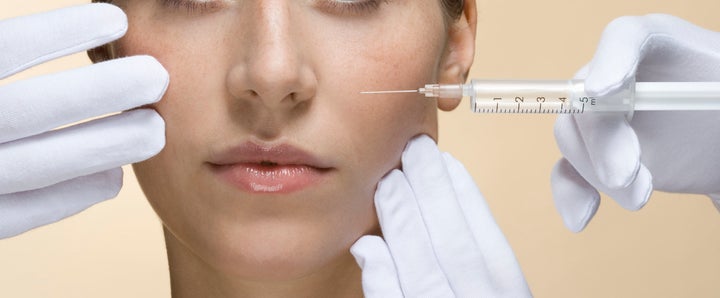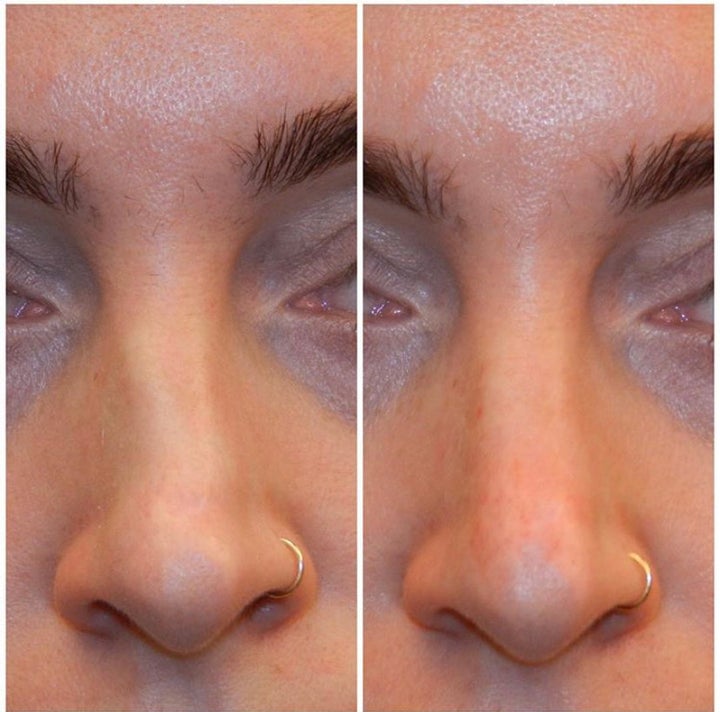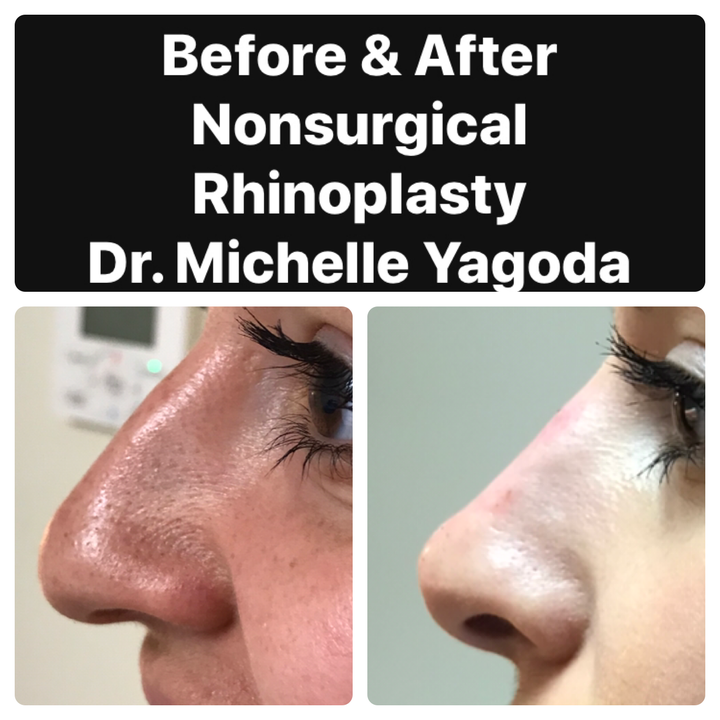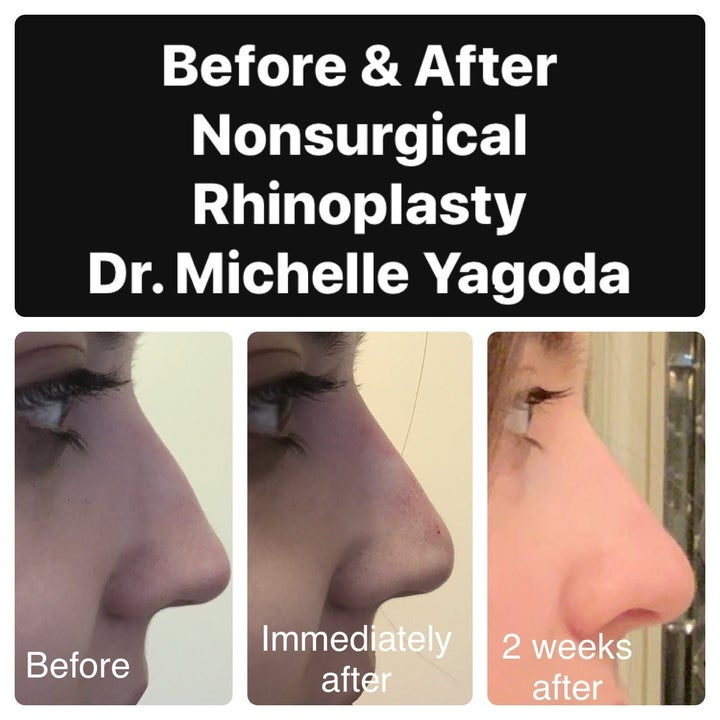
Nose reshaping was the third most popular surgical cosmetic procedure in the United States in 2017, according to the American Society of Plastic Surgeons. People seek nose jobs for various reasons both aesthetic and functional, from getting rid of the bump on their nose or straightening it to looking to correct breathing problems.
In 2017, over 215,000 nose reshaping procedures were performed. That number was a 2 percent decrease from 2016. One potential factor contributing to that decrease could be a trendy nose procedure that doesn’t require surgery at all.
Enter the nonsurgical rhinoplasty, also known as the “liquid nose job” or nonsurgical nose job. The procedure has been generating buzz online in recent years, so to learn more about it, we asked three plastic surgeons to share their expertise.
So what exactly is a nonsurgical rhinoplasty?
A nonsurgical rhinoplasty is a minimally invasive procedure that involves injecting fillers into the nose to alter its shape, the nostrils or bridge height, Dr. Michelle Yagoda, a board-certified plastic surgeon based in New York City, told HuffPost.
She added that a nonsurgical rhinoplasty can accomplish many of the things a surgical procedure can, though the results are temporary.
“Filler can also be used to modify the tip of the nose,” said Dr. Michael Dobryansky, a board-certified plastic surgeon at Long Island Plastic Surgical Group. “I use filler to inject the tip to make it crisper, turn it up, and make it more refined to provide facial harmony.”
Hyaluronic acid fillers are the most common fillers used in this procedure, according to Dr. David L. Cangello, a board-certified plastic surgeon in New York City. However, Dobryansky said that the hyaluronic acid fillers might sometimes be used in combination with a neurotoxin (like Botox). In rare cases, only a neurotoxin might be used, he added.
The actual procedure takes about 15 to 20 minutes, but might be slightly longer if a numbing cream is applied beforehand, Dobryansky said; numbing creams typically need 10 to 15 minutes to kick in.
Is it painful?
Cangello said the process is pretty painless, though some patients might feel a little discomfort for a short period afterward. Bruising is a possibility and swelling is likely, Dobryansky added.
In terms of downtime, there really isn’t any. Yagoda said within an hour, a person would be able to go about their business as usual.
How long does it last?
Unlike a surgical rhinoplasty, the results from this nonsurgical procedure are temporary, and last only as long as the fillers do, which can be anywhere from six to 12 months, Dobryansky said. Yagoda put the range between 10 months and a year.
“The resolution of filler is gradual,” Dobryansky said. “It is something that dissipates over time. Some people notice the changes sooner, and for others, it takes longer.”
It can help your nose appear straighter, but it doesn’t make it smaller.
As Dobryansky explained, a nonsurgical rhinoplasty doesn’t make the nose smaller. In fact, the fillers add volume to your nose, making it larger. It can, however, make a bump less visible or refine the shape of the nose.
In his opinion, a good candidate for this procedure is someone whose nose “is on the smaller size who wishes to make the nose straighter or modify the tip.”
Patients who undergo a nonsurgical rhinoplasty “have to be accepting of the fact that their nose will be bigger,” Dobryansky added.
What if you totally hate the result?
One of the benefits of nonsurgical rhinoplasty, Yagoda said, “is that if someone were to hate it, it can be removed by an injection of an enzyme that dissolves the filler and you’re back to where you started.”
The enzyme used to dissolve hyaluronic acid fillers is called hyaluronidase; if the fillers used were not hyaluronic acid-based, this enzyme will not break them down, Cangello said.
If you’re considering a nonsurgical rhinoplasty, there are a few more things to know.
For starters, all three doctors agreed that, generally speaking, the procedure should be considered a short-term solution that works best when used for fairly minor adjustments. It’s also not typically used to treat any functional issues one might be dealing with ― like problems with the sinuses ― whereas a surgical rhinoplasty can, Yagoda said. (Dobryansky did say, however, that there are some doctors using injectables to address issues like widening the airway inside the nose to help with breathing.)
In Cangello’s opinion, while a nonsurgical rhinoplasty might yield the desired results right away, the fillers won’t hold their shape forever. With repeated procedures, particularly when trying to add volume along the dorsum, he said, the filler “spreads through the nose tissue a little bit.” As a result, the tissues might start looking a little thicker and the nose might end up looking a wider over time.
Cangello said he believes the nonsurgical procedure works better when the individual is looking for minor changes. For example, he said, the fillers can fill in areas that are slightly curved.
“Using the filler to fill in those deficiencies to build the nose up and make it look straight is better, because you’re not asking this non-solid material to stand up and hold its place over time,” he said. “You’re just filling in little areas and creating an illusion to make the nose appear straighter.”
The nonsurgical rhinoplasty can also be used to make “microscopic changes” that don’t necessarily affect other parts of the nose over time, Yagoda added.
Some people also undergo a nonsurgical rhinoplasty before opting for surgery to give them idea of what they might look like if they choose to go under the knife, the doctors noted. With that being said, Yagoda suggested that if someone knows they ultimately want surgery, they shouldn’t have the nonsurgical procedure done more than two or three times maximum. Excess filler in the face could make surgery more difficult, she said.
Another reason nonsurgical rhinoplasties might be best for the short term is the cost, which can range anywhere from $800 to $2,000 per visit. If someone is having this procedure done regularly, for multiple years, they might still end up spending close to what they would have on surgery.
If you’re considering any type of medical procedure, be it a nonsurgical rhinoplasty or otherwise, you should always, always, consult with a certified doctor who can help you decide what’s best for you. You should also do your research: Ask questions, ask others about their experiences, and look at a doctor’s before-and-after photos, like the ones below, to get a better sense of their work.


